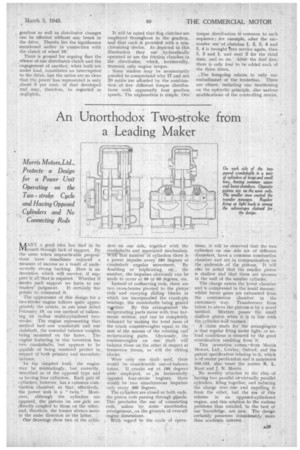An Unorthodox Two-stroke from a Leading, Maker
Page 21

If you've noticed an error in this article please click here to report it so we can fix it.
AANY a good idea has died in. its /Viyouth through lack of support. By the same token impracticable propositions have sometimes enjoyed a measure of success as a result of Linde.
• iervedly strong backing. .Here is an invention Which will survive, if support is all 'that is required. Whether it merits such support we leave to our
readers' judgment. It certainly has points to commend it. • .
The appearance of this design for a two-stroke engine follows quite appropriately the article, in ,otir issue dated February 19, on one method of balancing, in in-line multi-cylinderecl twostroke. The engine representing that method had one crankshaft and one camshaft, the essential balance weights being mounted on the latter, The engine featuring in this invention has two crankshafts, hut appears to be capable of being rendered perfect in, respect of both primary and secondary balance.
In the simplest form, the engine may be misleadingly, but correctly, described as of the opposed type and as having four cylinders. Each pair of cylinders, however, has a common combustion chamber', so that, effectively, the power unit is a " twin." Moreover, although the cylinders are opposed, the pistons on one „side are directly coupled to those on the other, and, therefore, the former always moire in the same direction as the latter.
Our drawings show two of the cylin ders on one side, together with the crankshafts and associated mechanism. Witrthisnumber—of cylinders there is a power impulte every 180 degrees of crankshaft angular movement. By doubling or triplicating, etc., the number, the impulses obviously can be made to occur at 90 or 60 degrees, etc.
Instead of corrnecting rods, there are two cross-beams pivoted to the piston rods and carrying sliding blocks in which are incorporated the crank-pin hearings, the crankshafts being geared NJ/ether. By this arrangement the reciprocating parts move with true harmonic motion, and can be completely balanced by making the total mass of the crank counterweights equal to the sum of the masses nf the rotating and reciprocating parts. Obviously, the counterweights on nue shaft will balance those on the other iii respect ef transverse forces, as will the sliding, blocks.
Were only one shaft • used, there would be considerable out-of-balance forces. If cranks set at 180 degrees were employed, as in horizontally opposed four-stroke engines, there would be two simultaneous impulses only every 360 degrees.
The cylinders are closed at both ends, the piston rods passing through glands. This precludes the use of connecting rods, unless by some unorthodox arrangement,,on the grounds of over-all engine dimensions. • With regard to the -cycle of opera tions, it will be observed that the two cylinders on one side are of different diameters, have a common combustion chamber and are in communication on the underside of the pistons. It will also be noted that the smaller piston is shallow and that there are recesses in the wall of the smaller cylinder.
The charge enters the lower chamber and is compressed in the usual manner, whilst burnt gases are exhausted from the combustion chamber in the customary way. Transference from below to above the pistons is by a novel method. Mixture passes the small shallow piston when it is in line with the cylinder-iiill recesses.
• A claim made for the arrangement is that regular firing under lightor noload conditions is ensured by the good stratification resulting from it.
This invention comes from Morris Motors, Ltd., Cowley, Oxford, and the patent specification relating to it, which is of recent publication and is numbered 550,155, also bears the names R. L. Kent and J. N. Morris.
No novelty attaches to the idea of having two parallel or virtually parallel cylinders, firing together, and inducing the charge into one and expelling it from the other, but the use of this scheme in an opposed-cylindered engine, and this solution to the various problems thus entailed, to. the best of our 'knowledge, are new. The design certainly possesses considerably snore than academic interest.




















































